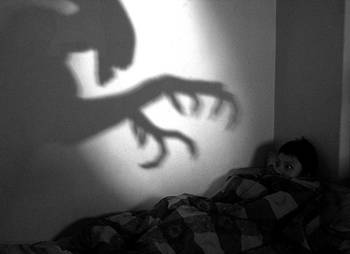Night terrors which also called as pavor nocturnus generally occur during sleep in the first third of the night, within midnight to 2 a.m. During a night terror the person generally sits up in bed and screams. The person feel confused and frightened as you are unable to comfort them. The episode can be last several minutes and they will go back to sleep. Most of them cannot explain what happened the next morning. They often have no memory of the event when they wake up on the next day.

The symptoms for night terror may be sweating, fast breathing (hyperventilating), fast heart rate, and dilated pupils. This condition usually happen to children around five to seven years old. The problem usually dissapears by age 12 or sooner. But, it can be to adults who are emotionally tension, overtired or alcohol drinker.
Nightmares are differ from night terrors. Nightmares are frightening dreams that usually very vivid and detailed. The content of the nightmare is frightening to the dreamer with common themes including being threatened, chased, hurt, or attacked. Although night terrors occur during non-rapid eye movement (NREM) sleep, nightmare occur during REM sleep. Since most of REM sleep occurs in the last third of the night, most nightmares also occur in the last third of the night.
Compared with night terrors, in which children frrequently do not recall their nocturnal experiences on awakening, the memories of nightmares are often carried into following day and may contribute to anxiety surrounding subsequent bedtimes. Memories of a terrifying nightmare can result in a child’s resistance to going to sleep, to sleping in his or her own bed, or to sleeping alone.
Usually night terrors and nightmares are not considered abnormal before 6 years of age. Parents who are aware of this and know how to handle such events are often relieved. However, night terror and nightmares in children older than 6 may be suggestive of an emotional disturbance. This disturbance is not necessarily serious but should be seek for counselling.
Experts believe that night terrors need to run their course, uninterrupted. They typically not lasted more than 20 to 30 minutes, after which the child become sleepy and falls back to sleep. When parents attempts to awaken or comfor their child, they may be prolonging the duration of the night terror. Instead, parents should go to their room to make sure their children did not harm themselves.
Children who seems to be excessively sleepy are also more aware to night terrors. Therefore it is important that children are getting enough sleep at night. On the other hand, children should be comforted after they experience a nightmare. A parent’s voice and affection may help the child come to the awareness that “it was just a dream and it is over now.”
If the frequency and intensity of the nightmares are severe, psychotherapy, behavioral techniques such as hypnosis, or medication that can reduces REM sleep would be benificial. However, only rarely do nightmares require treatment.

Leave a Reply